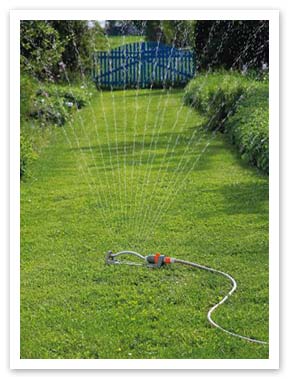Spring is an excellent time of year to sow a new lawn. The seed will germinate readily when the ground is warm and the late rains will help establish lawn before the heat of summer.
Because a lawn looks best when it is smooth, level and lush green, and because lawns need to be grown in the best possible soil conditions, it is essential that the area to be sown under lawn is specially prepared. It will need care, watering and feeding - but most of all careful preparation before sowing.
AREA TO BE GRASSED
 First you must ask yourself - is the area well drained and do I need to add more soil to raise or level the area, or just soil conditioner and fertiliser to make a good bed for the grass seed? In most average circumstances blended river sand 50% and topsoil 50% spread to a minimum, depth of 100 mm is adequate.
First you must ask yourself - is the area well drained and do I need to add more soil to raise or level the area, or just soil conditioner and fertiliser to make a good bed for the grass seed? In most average circumstances blended river sand 50% and topsoil 50% spread to a minimum, depth of 100 mm is adequate.
You will need to know the approximate length and width of the area to be sown. It is also important to take into account any irregularities in the site such as moderate or steep slopes, or the existence of established trees etc. The consistency of the soil, whether it is sandy, heavy clay, or whatever.
The amount of sunshine received by the area is also very important in the selection of seed types. Last, but not least, the amount of wear and tear expected is most important. A lawn that will become the sports arena for the neighbourhood kids and pets will obviously need to be of sterner stuff than one that is mostly for appearance with the occasional stroll across it to get the morning paper.
SITE PREPARATION
First, remove all rubbish and debris from the area, then add and spread any necessary topping of soil or loam. The area should then be soaked thoroughly for two to three hours in readiness for rotary hoeing. This should be carried out over the whole area and the soil turned over thoroughly to a depth of 15 cm.

Level the area, raking or screeding the soil to achieve a completely even or flat surface that has no bumps or low spots - either of which could cause problems with mowing and watering. Once you are satisfied with the level and evenness, lightly roll the whole area to compact the surface.
Mix the seed with an equal amount of coarse sand and broadcast the seed evenly by hand or spreader over the entire lawn area.
Finally, cross rake the site at right angles to the previous raking and lightly roll the whole area to settle the seed in and reduce the risk of seed wash,out with the first waterings.
 GETTING IT GROWING
GETTING IT GROWING
Use a gentle and fine sprinkler to thoroughly water the area.
From now on it is essential that the soil is not allowed to dry out at any stage until germination is complete and the young lawn seedlings have emerged. If the seeds dry out at any time after germination has started, they will wither and die.
Once the lawn has reached I to 2 cm high, the watering pattern can change and the sprinklers used daily for a period of 15 to 20 minutes in each position. Obviously, this will have to be more frequent if the weather turns hot.
THE FIRST CUTTING
Once the lawn has reached between 4-5 cm high for more than 70% of the total area you should commence cutting. Be careful that the mower is not too heavy as this can cause wheel ruts in the soft soil, ruining the levels and surface of the lawn. Sometimes it is advisable to use a hand mower for the first few mowings, for this reason.
Cut the lawn regularly every eight to ten days and remove the clippings by either raking after mowing, or with the use of a catcher on the mower.
ON-GOING MAINTENANCE
Provided the weather is not too hot at this stage, watering can now be carried out every second day, keeping the sprinkler on each spot for 20 to 30 minutes.
After three or four mowings, the waterings can be longer and further apart until you are eventually down to one slow deep soaking per week. The best time to water your lawn is immediately after sunrise, so that the lawn is equipped to handle the hottest day.
 If your new lawn shows any sign of wilting it will usually mean that you are not providing enough water at each watering.
If your new lawn shows any sign of wilting it will usually mean that you are not providing enough water at each watering.
Feed your new lawn after its second mowing with one of the many lawn foods and spread it evenly to ensure that the new growth is uniform across the lawn.
The lawn must be dry before the fertiliser is added and then thoroughly watered-in immediately you have finished spreading the area to ensure even application and maximum effect. Feed the lawn again in a months time.
To maintain your lawn in good colour and health, give it a good feed with broadcast granules or with a liquid or spray on fertiliser, ideally at the change of each season.